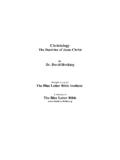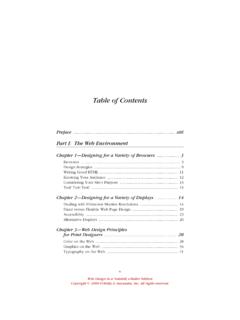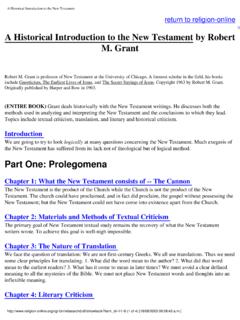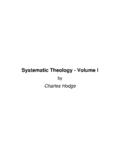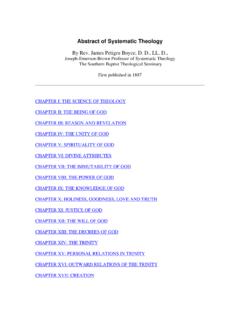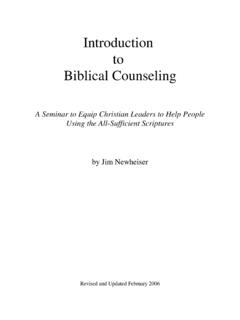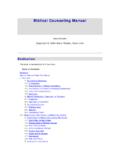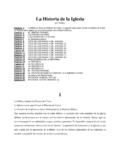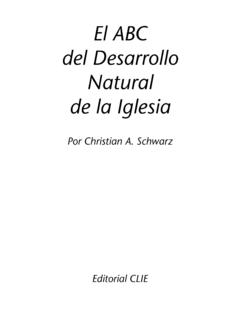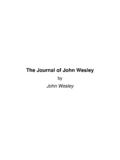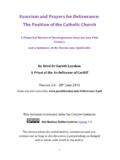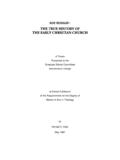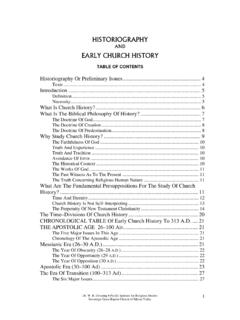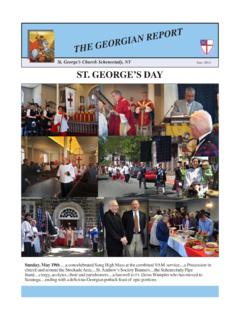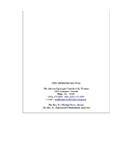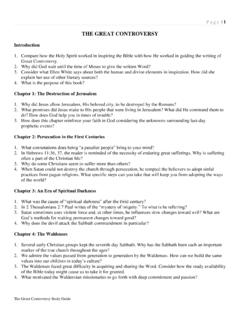Transcription of © New Tribes Mission, Inc. Doctrine 3 Class Notes
1 New Tribes mission , Inc. 10/6/2004 9:59 AM Thomas Freeman Page 1 Doctrine 3 Class Notes New Tribes mission , Inc. 10/6/2004 9:59 AM Thomas Freeman Page 2 I. INTRO - 3 A. DEFINITION OF 3 B. HISTORY OF THE Doctrine OF THE HOLY 3 1. Recognized a limitation on the duration of sign gifts and 3 2. Sabellianism (Emanations) .. 3 3. Arianism (Tri-Theism) .. 4 4. Soteriological 4 5. Priests instead of the Holy Spirit for the common 4 6. Reformation 4 7. Sanctification Views .. 5 8. Summary 5 C. WHO IS HE?.. 6 1. Person .. 6 2. 6 D. WHAT DOES HE DO? .. 7 1. Relationships .. 7 2. 7 II. WHO IS HE? .. 8 A. 8 1. 8 2. Mind / 8 3. Will .. 8 4. Unique Spirit Being (Gender Neutral) .. 9 5. Relates to other 9 B.
2 10 1. Characteristics of 10 2. Referred to as 10 3. Third Person of the Trinity .. 10 III. WHAT DOES HE DO? .. 12 A. RELATIONSHIPS AND .. 12 1. To the 12 2. To OT 13 3. To Jesus in His 14 4. To the Disciples .. 15 5. To the 16 6. To the Church .. 18 7. To the Tribulation individuals .. 30 8. To the Millennium Kingdom .. 30 9. To the 31 IV. RECOMMENDED BOOK 32 1. 32 2. 32 New Tribes mission , Inc. 10/6/2004 9:59 AM Thomas Freeman Page 3 I. Intro - Overview A. Definition of Pneumatology Pneumatology is specifically the study of all things dealing with spirits. However, the common concept of Pneumatology among theologians is the study of the person and work of the Holy Spirit. DEFINITION = the theological study of the person and work of God the Holy Spirit.
3 B. History of the Doctrine of the Holy Spirit Bibliography: John F. Walvoord, The Holy Spirit, Chapter 26 Henry Thiessen, Introductory Lectures in Systematic Theology, pg. 145 Charles Ryrie, Basic Theology, Chapter 68 The early church did hold to a proper Doctrine of the Holy Spirit. There were heretical groups (Gnostics, Ebionites and followers of Simon Magnus2) but they were not considered part of the church. The early church reverenced the Holy Spirit first and foremost in its devotional literature. As time progressed, it became more necessary to document what they believed and accepted from their studies of scripture. Thus the writings of the early church fathers began to provide specific doctrines of the Holy Spirit in the second and third 1.
4 Recognized a limitation on the duration of sign gifts and revelation One heretical group was Montanism. In response, the early church stood against special revelation outside of the Word of God and that the sign gifts were never promised to be the Church s permanent possession. This was around the 1st century. 2. Sabellianism (Emanations) This view from the first century rejected 3 separate persons. It viewed the Son and Holy Spirit as only modes of manifestation. One God who appeared in different forms for specific purposes. ! " # # " # $% & Today s Unitarian views are a modified form of this early heresy. It was also the first major error to gain a following in the early church.
5 1 John F. Walvoord, The Holy Spirit A Comprehensive Study of the Person and Work of the Holy Spirit, Zondervan 1991, pg 237 2 John F. Walvoord, pg 238 3 John F. Walvoord, pg 239 4 John F. Walvoord, pg 239 5 John F. Walvoord, pg 241 New Tribes mission , Inc. 10/6/2004 9:59 AM Thomas Freeman Page 4 These views would fall into the category of Emanations. 3. Arianism (Tri-Theism) This early church heresy held the opinion that Christ and the Holy Spirit were created beings. It even went on to teach that Christ created the This view resulted in the logical conclusion that a being created by another being cannot be equal and eternal with the first being.
6 Thus they were three distinct individuals with hierarchy of quality. Father Son Holy Spirit. These views would fall under the category of Tri-Theism the View that there are three distinct gods rather than three persons who are also one God (3 in 1). The position of the early church fathers was to declare a belief in the Holy Spirit. They did not attempt to combat this view until the 4nd century. ' ' () * ' + , - . - / / 0 1 . / 2 3 4. Soteriological Views Augustine was influential in developing views on the salvation influence of the Holy Spirit. Again, this attention was stimulated by a heretical view which was on the arise in the 5th century.
7 Pelagius, a British monk who traveled to Rome, believe that there was a little good in every man that allowed him to do good works apart from God s grace - Pelagianism. The pendulum swing against this view was to believe that man was so depraved that he was not only unable to do good, but was unable to mentally trust in God without a regenerating work of the Holy Spirit. A separate view, held by the Roman Catholic church, believed that man was in able to do good until the Holy Spirit did a first work in the man, then he was able to do good. This view was referred to as Semi-Pelagianism and ultimately became the view of Roman Catholicism. However there was a time in the 6th century when it was rejected 4 5 6&$78 9: ; 2 9: " ' ) 5.
8 Priests instead of the Holy Spirit for the common man During the middle ages, the development of the Doctrine of the Holy Spirit came to a standstill. The church expressly denied that the Spirit of God could teach all Christians through the Word of The priest was the sole explainer of the Word of God and took the place of the Spirit of God. 6. Reformation Views When the Roman Catholic Church was challenged by the reformation, much focus was turned again to the Doctrine of the Holy Spirit. As before, when refuting false Doctrine , correct Doctrine becomes clearer. At this time, the reformers rejected the priests as the sole explainer of the Word of God. They rather turned back to the Holy Spirit as the illuminator of the Word.
9 6 John F. Walvoord, pp 240-241 7 John F. Walvoord, pp 242-243 8 John F. Walvoord, pg 245 9 John F. Walvoord, pg 246 New Tribes mission , Inc. 10/6/2004 9:59 AM Thomas Freeman Page 5 The soteriological views became much more of an issue at this time. The Doctrine of Election (where God chooses someone for salvation and then the Spirit regenerates them) was defined. In opposition to this view was the view that man had not ability to do good works, but could mentally assent to trust in God and thus receive the Holy Spirit. 7. Sanctification Views Finally developed were the views that the Holy Spirit enables the believer to present the full life of Christ.
10 These views were more clearly developed by the movement of the Plymouth Brethren in the 19th century. 8. Summary Chart Had a proper Doctrine of the Holy Spirit in an undefined s tate. Montanis m (believed that God was giving new revelation through the s ign gifts ) was rejected - 1s t Century Sabbellianis m (An Emanation Vie w that God appeared in different form for s pecific purpos es ) - 261 Arianis m (One of the T ri-Theis tic views ) said that the Father created Christ and Christ the Spirit. - 381 Soteriological v iews were defined during the 5th Century. These views defined His regenerating work. Priests replace d Holy S pirit during the middle ages Reformation - Illuminati on was re-emphasized a llowing for each believer to s tudy God s Word.
